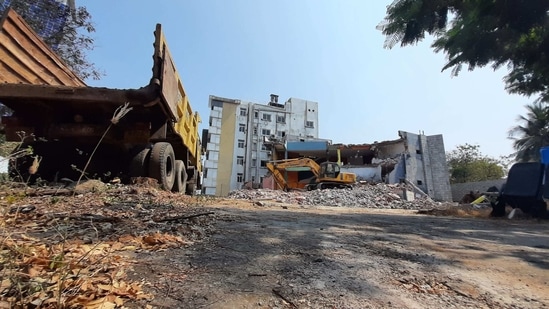MF Husain’s legacy in Hyderabad now reduced to rubble
MF Husain's museum, Cinema Ghar, was inaugurated in 1999 by Bollywood actor Madhuri Dixit and housed rare collections of the renowned artist from various phases of his life.
“It is sad that we are not able to preserve the precious legacy of [MF] Husain saab,” said Hyderabad-based artiste Laxman Aelay, days after Husain’s unique museum, Cinema Ghar, was razed last week.

Located at the vantage point on Road No. 12 of the upscale Banjara Hills in Hyderabad, MF Husain's museum was inaugurated in 1999 by Bollywood actor Madhuri Dixit and housed rare collections of the renowned artist from various phases of his life.
Husain’s family sold the property last year, where a commercial complex is likely to come up.
“Yes, we sold the property last year. I am not aware what is coming up there,” said Shafaat Husain, the artist’s eldest son.
Shafaat did not divulge details of where the rare collections were being housed. “What do you do with them?” he said.
The paintings and other collections were shifted to Mumbai soon after Husain’s death in London on June 9, 2011, Aelay said.

A peculiar feature of the Cinema Ghar was that while there were only two colours on the building’s elevation from outside – black and white with Husain’s trademark sketches carved out on the walls – the walls on the insides of the museum were huge canvasses of vibrant colours with several abstract and realistic paintings. The museum also housed a 50-seat cinema theatre, equipped with Dolby sound system and a library of nearly 2,000 books on art, cinema, music and science.
There was also an exhibition hall to accommodate larger art pieces. A gallery with photos of Dada Saheb Phalke, Madhuri Dixit, and Tabu, along with video and digital albums of musicians from the Beetles to A R Rahman and Urvashi to Martha Graham, was also set up inside the museum.
“It was a feast for art lovers to visit this museum and spend time there. I had an opportunity to picturise every part of Cinema Ghar. I had the privilege of having a cup of tea with Husain sir in this lobby and take his innumerable pictures. It is sad to know that this magnificent edifice is not to be seen any more,” says photographer K R Vinayan, who has made a pictorial book on Cinema Ghar.
Married to Fazila, a Bohra Muslim from the city’s Hussaini Alam area, the artist remained close to Hyderabad. “He used to make surprise appearances in the streets of Hyderabad walking bare-footed; have a cup of an Irani chai at a street corner café in Secunderabad and take a stroll on the Tank Bund on the banks of Hussainsagar. Hyderabad was like his second home,” Mir Ayoob Ali Khan, a senior journalist, said. In 2006, when Husain received death threats in Mumbai, he considered shifting base to Hyderabad. “But he moved to Qatar for reasons known to him, and from there to London, where he passed away,” Khan said. Writer Anju Poddar, who was a close friend of Husain, also expressed regrets that the museum has been razed to rubble.






